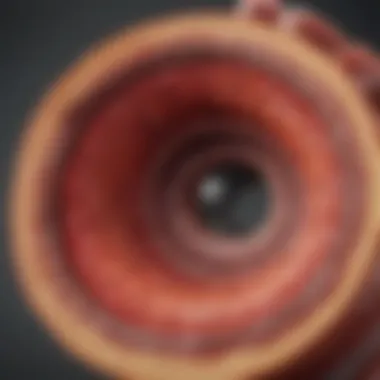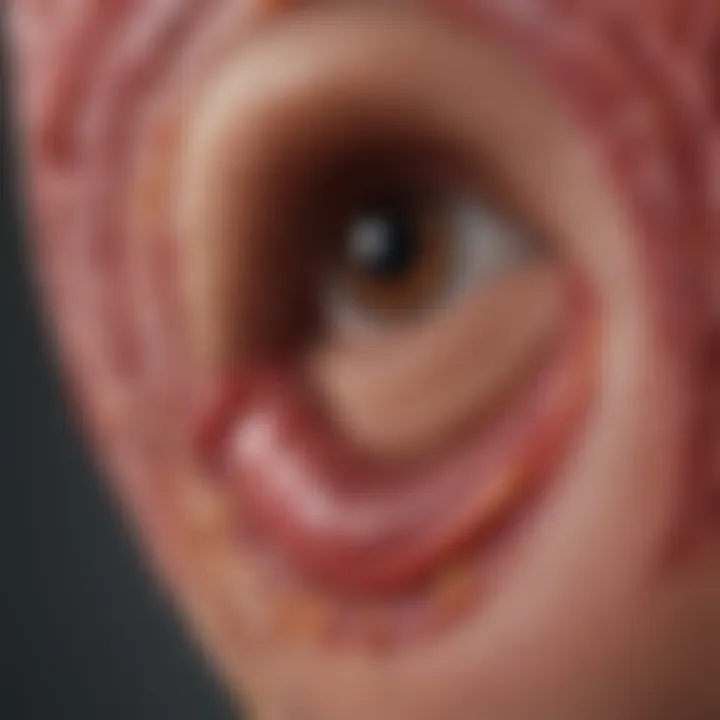Reversal of Atherosclerosis: Advances & Implications


Intro
Atherosclerosis is a complex condition that plays a crucial role in the development of cardiovascular diseases. Its progression is influenced by various factors, including lifestyle choices, genetic predispositions, and environmental influences. The condition often leads to serious health complications, making it imperative to understand its underlying mechanisms and explore potential reversal strategies. In recent years, significant advancements have emerged in this field, from lifestyle modifications to innovative treatments, which can potentially offset the negative outcomes associated with this disease.
This article seeks to provide a comprehensive overview of the reversal of atherosclerosis, delving into recent research and its implications for public health. The insights gained from these studies inform prevention strategies and therapeutic efforts aimed at improving patient outcomes.
Preface to Atherosclerosis
Atherosclerosis is much more than a medical term. It represents a key factor in understanding cardiovascular diseases that afflict millions worldwide. The topic is essential to this article as it lays the groundwork for discussing advances in the reversal of this condition. Understanding atherosclerosis is crucial for anyone interested in health, medicine, or even public policy. The underlying processes contribute significantly to morbidity and mortality rates linked to heart diseases. In the journey of this article, numerous layers of this condition will be uncovered, highlighting the intricate relationship between its definition, pathology, epidemiology, and approaches for intervention.
Definition and Pathophysiology
Atherosclerosis is defined as the progressive accumulation of lipids, inflammatory cells, and fibrous elements in the arterial walls. This combination leads to the thickening of arterial walls and the narrowing of blood vessels. The pathophysiological mechanisms at play involve several complex processes, including endothelial dysfunction, lipid infiltration, and inflammatory response.
Endothelial cells, which line the blood vessels, are critical to maintaining vascular health. When these cells become damaged due to factors like high cholesterol or hypertension, they become more permeable. This permeability allows lipoproteins, particularly low-density lipoprotein (LDL) cholesterol, to penetrate the arterial wall. Once inside, LDL undergoes oxidation and triggers an inflammatory response, recruiting immune cells such as monocytes. These cells differentiate into macrophages and ingest the oxidized lipids, creating foam cells. Over time, foam cells accumulate and form fatty streaks that evolve into mature plaques.
Complications arise when plaques rupture, leading to thrombosis and potential occlusion of blood flow. This occlusion can result in acute cardiovascular events, such as heart attacks and strokes. Therefore, understanding the precise definition and physiological pathways of atherosclerosis is vital for developing effective strategies to combat this condition.
Epidemiology of Atherosclerosis
Epidemiologically, atherosclerosis is a leading cause of cardiovascular diseases and remains a global health challenge. Its incidence varies across different populations and demographics. Risk factors are often modifiable and include smoking, poor diet, physical inactivity, and high blood pressure. Moreover, non-modifiable factors such as age, gender, and genetic predisposition also play a significant role.
Statistics indicate that atherosclerosis begins much earlier in life than previously acknowledged, with the presence of atherosclerotic lesions found even in adolescents. Different regions have different prevalence rates, often linked to lifestyle and socioeconomic factors. For instance, urban populations may demonstrate higher rates due to dietary habits and environmental stressors compared to rural populations.
Recognizing these patterns allows healthcare professionals to prioritize prevention strategies effectively. Targeted education and interventions focused on at-risk groups can greatly reduce the future burden of cardiovascular diseases attributable to atherosclerosis. By delving into the epidemiological aspects of this condition, this article aims to emphasize the importance of proactive rather than reactive measures in public health.
"Understanding atherosclerosis is not only crucial for medical practitioners but also for policymakers aiming to reduce the burden of cardiovascular diseases on society."
By gaining insights into both its definition and pathology, as well as its epidemiological trends, we can better appreciate the significance of reversing atherosclerosis. With this foundational knowledge, we can explore innovative treatments and lifestyle modifications that hold promise for improving health outcomes.
The Role of Lipids in Atherosclerosis
Lipids are a fundamental component in the development and progression of atherosclerosis. Understanding their role is essential in evaluating both the risk of this condition and potential therapeutic strategies aimed at its reversal. Lipids, particularly cholesterol, contribute significantly to plaque formation in the arterial walls. This accumulation leads to the narrowing of arteries, ultimately resulting in cardiovascular complications. Investigating lipid behavior provides insights that might inform better prevention tactics and treatment options.
Cholesterol Transport Mechanisms
Cholesterol transport within the body occurs through several mechanisms involving lipoproteins. These lipoproteins, including low-density lipoprotein (LDL) and high-density lipoprotein (HDL), play crucial roles in lipid metabolism. LDL is responsible for delivering cholesterol to cells, while HDL helps in removing excess cholesterol from tissues and returning it to the liver for excretion. The imbalance between LDL and HDL levels can significantly impact cardiovascular health.
Elevated LDL levels are often linked with increased atherosclerosis risk. Conversely, higher levels of HDL are usually associated with a protective effect against plaque buildup. Understanding these mechanisms can guide interventions aimed at managing lipid levels effectively.
Impact of Lipoproteins on Plaque Formation
The types of lipoproteins present in the bloodstream can greatly influence plaque stability and vulnerability. LDL is commonly recognized for its role in promoting atherosclerosis. When oxidized, LDL becomes particularly harmful, leading to inflammation and recruitment of immune cells to the arterial wall. This process facilitates plaque formation, increasing the risk of rupture and subsequent cardiovascular events.
Conversely, HDL exerts protective effects by mitigating inflammation and promoting cholesterol efflux from macrophages. Enhanced clearance of lipids via HDL reduces the likelihood of plaque formation. Thus, therapeutic strategies focused on modifying lipoprotein levels, either through lifestyle changes or pharmacological interventions, can be effective in reversing atherosclerosis.
It is essential to understand these dynamics, as they pave the way for targeted approaches in both treating and preventing atherosclerotic disease.
"Recent research continues to uncover the complexities of lipid behavior and their implications for heart health."
Effective management of lipoprotein levels can serve as a cornerstone for innovative therapies that aim to reverse atherosclerotic progress and enhance patient outcomes.
Inflammation and Immunity in Atherosclerosis
Inflammation plays a critical role in the pathogenesis of atherosclerosis. This section looks into the interactions between inflammation and immunity in the development and progression of atherosclerosis. Specifically, we explore how these processes contribute to plaque formation and stability, emphasizing their importance in reversing atherosclerosis and enhancing overall health outcomes.
Inflammatory Pathways Involved
A wide range of inflammatory pathways are implicated in atherosclerosis. These pathways trigger a cascade of events leading to endothelial dysfunction, lipid accumulation, and ultimately plaque formation. Notably, the activation of Nuclear Factor kappa-light-chain-enhancer of activated B cells (NF-κB) plays a significant role. NF-κB regulates the expression of various pro-inflammatory cytokines and adhesion molecules that promote the recruitment of immune cells to the endothelial wall.
Moreover, factors like interleukin-1 (IL-1) and tumor necrosis factor-alpha (TNF-α) are released from activated macrophages, perpetuating the inflammatory response. The NLRP3 inflammasome, a crucial component of this process, is also of interest. Upon activation, it leads to the maturation and secretion of IL-1β, which drives inflammation further.
Recognizing these pathways is essential not only for understanding the progression of atherosclerosis but also for developing targeted therapies aimed at regulating inflammation and thus reversing the disease.
Role of Immune Cells in Plaque Stability
Immune cells profoundly influence plaque stability, which is vital for atherosclerosis management. Macrophages, T-cells, and B-cells all contribute distinctively to plaque composition and dynamics. Macrophages can adopt different phenotypes, including pro-inflammatory (M1) and anti-inflammatory (M2) states. The balance between these states affects plaque progression.


In unstable plaques, predominance of M1 macrophages leads to more inflammation, which can cause ruptures, increasing the risk of heart attack.
T-cells also play diverse roles. CD4+ T-cells contribute to the inflammatory response, while regulatory T-cells (Tregs) promote resolution of inflammation and plaque stability. Overall, therapies targeting immune cell behavior show promise in stabilizing plaques, preventing acute cardiovascular events.
Diagnostic Approaches
Diagnostic approaches are crucial in understanding and managing atherosclerosis. The ability to detect early signs of arterial plaque buildup allows for timely interventions. Early diagnosis can significantly alter the disease course, potentially reversing or halting progression. This section delves into the main diagnostic strategies that healthcare professionals employ to identify this condition effectively.
Imaging Techniques for Atherosclerosis
Imaging techniques provide invaluable insights into the arterial structure and function. Different modalities serve distinct purposes.
- Ultrasound: This is widely used for its accessibility and cost-effectiveness. Carotid ultrasound can detect plaque in the carotid arteries, offering a non-invasive way to assess atherosclerosis.
- Computed Tomography (CT): Coronary CT angiography allows visualization of coronary arteries. It can identify the presence of calcium in the arteries, which is an indicator of atherosclerosis.
- Magnetic Resonance Imaging (MRI): While less commonly used than CT, MRI offers a detailed view of blood vessels and plaques without the use of radiation.
Each of these techniques has its strengths and limitations. For example, while CT scans can reveal calcium deposits, they might not show soft plaques well. Understanding these nuances helps clinicians choose the appropriate test based on patient needs.
Key Point: Accurate imaging is essential. It could help predict cardiovascular events and guide treatment decisions.
Biomarkers for Risk Assessment
The use of biomarkers in atherosclerosis diagnostics complements imaging techniques. Biomarkers serve as indicators of disease presence or risk, often providing critical information about underlying processes.
- Lipid Profile: Measurements of total cholesterol, LDL, HDL, and triglycerides are foundational in assessing risk. Elevated LDL levels are particularly concerning as they contribute to plaque formation.
- C-reactive Protein (CRP): This inflammatory marker can reflect systemic inflammation associated with atherosclerosis. An elevated CRP level may indicate a higher risk of cardiovascular events.
- High-sensitivity Troponin: This biomarker can indicate myocardial injury, complicating atherosclerosis, and is useful for risk stratification in cardiac patients.
Incorporating biomarker evaluations complements imaging modalities. They provide a broader understanding of an individual's risk profile, thereby allowing for targeted interventions. Together, these diagnostic approaches form a comprehensive framework for understanding atherosclerosis and developing effective management strategies.
Lifestyle Modifications
Lifestyle modifications play a critical role in reversing atherosclerosis. These changes can significantly impact cardiovascular health and lower the risk of complications associated with cardiovascular diseases. The benefits of these modifications extend beyond merely addressing lipid levels. By altering daily habits and improving overall well-being, patients may find themselves on a path to better health outcomes.
A key aspect of lifestyle modifications includes dietary interventions. Nutrition directly affects lipid levels and inflammation, both of which are central to the progression of atherosclerosis. Making informed choices about food can lead to improved heart health. It is also important to consider how different foods interact with the body's systems.
Another vital component is physical activity. Regular exercise strengthens the heart, improves circulation, and helps manage weight. Engaging in consistent physical activity acts is an anchor for numerous health benefits, reducing the risk of atherosclerosis progression.
Finally, smoking cessation cannot be overlooked. Smoking is a major risk factor for atherosclerosis. When individuals quit smoking, they gain an opportunity to improve their cardiovascular health. The positive effects of reducing or eliminating tobacco use can be profound.
"Making a few simple modifications to daily routines can have a lasting impact on cardiovascular health."
In summary, lifestyle modifications encompass dietary changes, increased physical activity, and smoking cessation. These elements not only help to reverse existing atherosclerosis but also foster a long-term commitment to better health. Each of these modifications is interrelated, creating a holistic approach to managing cardiovascular risks.
Pharmacological Interventions
Pharmacological interventions play a crucial role in the reversal of atherosclerosis. These therapies are particularly important because they address the underlying mechanisms of the disease. By targeting lipid levels and inflammatory processes, pharmacological treatments help to stabilize and even regress atherosclerotic plaques. Among the various options available, statins and novel antilipidemic drugs have gained significant attention. Understanding their mechanisms and effects is essential for utilizing these therapies effectively.
Statins: Mechanisms and Efficacy
Statins are widely regarded as the cornerstone of pharmacological management in atherosclerosis. Their primary mechanism involves inhibiting the enzyme HMG-CoA reductase, which plays a key role in cholesterol biosynthesis in the liver. By reducing the production of cholesterol, statins lead to a significant decrease in low-density lipoprotein (LDL) cholesterol levels in the bloodstream.
The efficacy of statins in reducing cardiovascular events is well-documented. Research consistently shows that statin therapy can decrease the incidence of heart attacks and strokes by stabilizing existing plaques and potentially reducing their size. The anti-inflammatory properties of statins also contribute to their effectiveness; they decrease markers of inflammation and promote endothelial health.
Key benefits of statins include:
- Reduction in LDL cholesterol
- Stabilization of atherosclerotic plaques
- Decrease in cardiovascular events
- Improvement of endothelial function
However, it’s essential to consider potential side effects. Some patients may experience muscle-related symptoms or liver abnormalities. These risks necessitate careful monitoring and individualized treatment plans to maximize benefits while minimizing adverse effects.
Novel Antilipidemic Drugs
Novel antilipidemic drugs represent a new frontier in the pharmacological treatment of atherosclerosis. These medications, which include PCSK9 inhibitors and therapies targeting other pathways, offer alternative means of lowering cholesterol and improving patient outcomes.
PCSK9 inhibitors, such as evolocumab and alirocumab, provide another layer of lipid-lowering therapy. By inhibiting the protein PCSK9, these drugs increase the liver's ability to remove LDL cholesterol from the bloodstream. Clinical trials have shown that PCSK9 inhibitors can significantly lower LDL levels and reduce the risk of cardiovascular events in patients who are statin-resistant or have genetic lipid disorders.
The integration of these innovative therapies into treatment protocols has profound implications for patients. The potential benefits include:
- Lowering LDL cholesterol beyond what statins achieve
- Decreased risk of heart disease in high-risk individuals
Despite their promise, these novel therapies can be expensive, which raises concerns regarding access and equity in treatment. Therefore, understanding their clinical applications and cost-effectiveness is crucial for healthcare providers as they make decisions regarding patient management.


"The development of novel antilipidemic drugs reshapes the landscape of atherosclerosis treatment, providing new hope for patients with high cholesterol levels."
Pharmacological interventions continue to play an essential role in combating atherosclerosis. Ongoing advancements in drug development promise to refine our understanding and improve treatment strategies for this pervasive condition.
Innovative Therapeutic Approaches
The realm of atherosclerosis treatment has evolved significantly in recent years, paving the way for innovative therapeutic approaches that hold potential for reversing this chronic condition. Innovations are not merely incremental changes but represent a paradigm shift in understanding and managing atherosclerosis, focusing on targeted strategies that attack its roots rather than simply addressing symptoms. These therapies aim to stimulate biological processes that repair vascular damage or restore vascular health, offering hope for improved patient outcomes.
Among the most promising areas of research are gene therapies and cell-based therapies. These target the complexity of atherosclerosis at the molecular and cellular levels. The goal is to modify underlying mechanisms that contribute to plaque formation and instability. Given the multifactorial nature of the disease, approaches that harness biological processes hold significant promise.
Gene Therapy and its Implications
Gene therapy represents a cutting-edge approach aimed at altering the genes involved in atherosclerosis development. By introducing or modifying genetic material within a patient’s cells, the therapy seeks to correct underlying abnormalities. For instance, one focus is on the production of proteins that can enhance lipid metabolism or reduce inflammation—two critical components of atherosclerosis.
The implications of gene therapy are profound. Outcomes can lead to:
- Potential for long-lasting effects: Unlike traditional medications, which typically require ongoing administration, gene therapy could offer sustained therapeutic benefits.
- Precision medicine approach: It allows for tailored treatments based on an individual's genetic makeup, targeting specific pathways relevant to their condition.
- Reduction in side effects: By directly modifying the biological processes involved, there could be a decrease in the unintended consequences that often accompany pharmaceutical interventions.
Nonetheless, the clinical application of gene therapy raises ethical considerations, including concerns about safety and the long-term impacts of altering human genes. Regulatory frameworks will need to evolve to accommodate these advancements, ensuring the balance between innovation and patient safety.
Cell-based Therapies
Cell-based therapies, another innovative approach, leverage the capabilities of various cell types to promote healing and reversal of atherosclerosis. This strategy involves the use of stem cells or progenitor cells capable of differentiating into specific cell types that can repair atherosclerotic damage or enhance healing.
The benefits of cell-based therapies include:
- Regenerative potential: These therapies can revive damaged tissues by promoting new cellular growth and function, addressing not just symptoms but the root causes.
- Immune modulation: Certain cell types can regulate immune responses, potentially reducing chronic inflammation associated with atherosclerosis.
- Enhanced plaque stability: By integrating healthy cells into arterial walls, cell-based therapies may improve plaque stabilization, reducing the risk of rupture and subsequent cardiovascular events.
However, similar to gene therapy, the application of cell-based therapies requires careful consideration. Issues such as the source of cells, potential immune rejection, and long-term effects must be thoroughly investigated. Regulatory bodies will play an essential role in overseeing these treatments to uphold safety standards.
As research continues to unfold, both gene and cell-based therapies present a frontier in the fight against atherosclerosis, reshaping treatment paradigms and nurturing better cardiovascular health.
The Impact of Technology on Treatment
The role of technology in the treatment of atherosclerosis cannot be overstated. As researchers continue to uncover the complexities of this disease, technological advancements provide critical support. Innovations in treatment methodologies not only enhance the effectiveness of existing therapies but also pave the way for novel interventions. The integration of technology allows for improved monitoring, precise risk assessment, and the development of personalized treatment plans. It serves to deepen our understanding of disease processes and refine our strategies for reversal and prevention.
Technological advancements improve the efficiency and outcome of therapies aimed at reversing atherosclerosis. These innovations widen the scope of treatment possibilities and lead to better management of the condition. As we delve further into the specifics, two noteworthy areas emerge: artificial intelligence in risk prediction and wearable technology for monitoring.
Artificial Intelligence in Risk Prediction
Artificial intelligence (AI) represents a transformative force in many medical fields, including cardiology. Its application in risk prediction for atherosclerosis allows clinicians to process vast amounts of data with greater accuracy. AI can identify patterns and correlations within diverse datasets, which aids in predicting individual risk factors for cardiovascular issues.
Machine learning algorithms analyze data from demographics, clinical history, and imaging results to assess the likelihood of atherosclerosis progression. These predictions enable healthcare providers to tailor interventions more effectively and allocate resources where they are most needed. Some key points about this technology include:
- Data Integration: Combining various data types, such as genetic, clinical, and lifestyle factors, leads to a comprehensive risk profile.
- Early Intervention: Recognizing high-risk individuals allows for earlier lifestyle modifications or pharmacological treatments, reducing potential complications.
- Continuous Learning: AI systems continuously improve through iterative learning processes, becoming more effective over time.
"The future of cardiovascular care lies in personalized approaches, driven by data and technology."
Such systems might fundamentally improve treatment outcomes by predicting critical events before they happen, thus enhancing preventive measures and individualizing care.
Wearable Technology for Monitoring
Wearable technology is another significant advancement in the landscape of atherosclerosis treatment. Devices such as smartwatches and fitness trackers enable continuous health monitoring and provide real-time data on an individual’s cardiovascular health. These devices empower patients to take charge of their health by tracking vital signs, physical activity, and even stress levels.
Key advantages of wearable technology include:
- Real-Time Monitoring: Users can keep track of their heart rate, blood pressure, and activity levels, allowing for immediate feedback.
- Data Accessibility: Patients can share real-time data with healthcare providers, fostering a collaborative approach to managing their conditions.
- Behavioral Insights: Such technology can help identify patterns in daily habits that contribute to cardiovascular health, thus guiding lifestyle adjustments.
The use of technology in monitoring paved a path for a proactive approach toward managing atherosclerosis. Patients can engage in preventative behavior based on data, possibly leading to better health outcomes and reduced healthcare costs.
Public Health Implications
The implications of reversing atherosclerosis extend beyond individual health to encompass broader public health considerations. As a leading cause of cardiovascular disease, understanding the mechanisms and potential pathways for reversal is crucial for developing effective prevention strategies. Atherosclerosis not only affects the individuals suffering from it, but also creates a significant burden on healthcare systems worldwide. The economic costs associated with treating cardiovascular diseases, which can include hospitalization, chronic care, and medication, are staggering. Thus, advancing knowledge in this field can contribute to substantial public health benefits.
Key aspects of public health implications include:
- Reduction in Cardiovascular Events: Reversing atherosclerosis can lead to fewer heart attacks and strokes, enhancing life expectancy and quality of life.
- Economic Savings: Effective prevention and treatment of atherosclerosis can reduce healthcare expenditures, allowing resources to be allocated to other pressing public health needs.
- Improved Quality of Life: Patients who manage to reverse their atherosclerotic conditions can experience better health, leading to greater productivity and decreased absenteeism in workplaces.


These elements underscore how important it is for policymakers, healthcare providers, and researchers to prioritize strategies that address atherosclerosis reversal.
Policy Recommendations for Atherosclerosis Prevention
In order to combat the rising tide of atherosclerosis effectively, several key policy recommendations should be implemented:
- Incentivizing Healthy Lifestyles: Governments should create policies that encourage physical activity and healthy eating through financial incentives or subsidies. For instance, lowering taxes on healthy foods while increasing taxes on processed options can promote better dietary choices.
- Comprehensive Screening Programs: Establishing nation-wide screening initiatives for high-risk populations can help in early identification and management of atherosclerosis risk factors. Early intervention is critical, as it has the potential to reverse the progression of the disease before it leads to severe outcomes.
- Education on Cardiovascular Health: Policies should mandate educational campaigns that inform the public about the risk factors of atherosclerosis and the importance of maintaining cardiovascular health.
- Access to Healthcare Services: Ensuring equitable access to healthcare services is essential. This can be accomplished by government programs that provide better coverage for preventive measures and chronic disease management.
By adopting these recommendations, policymakers can create a more health-forward society, addressing the root causes of atherosclerosis and facilitating the work of healthcare providers in their efforts to reduce cardiovascular risks.
Education and Awareness Initiatives
Education and awareness initiatives play a vital role in reversing atherosclerosis. They equip individuals with the necessary knowledge and skills to manage their health effectively.
To boost these initiatives, several approaches should be taken:
- Community Workshops: Organizing workshops to educate communities about the impact of diet and exercise on cardiovascular health can foster healthier lifestyles. These workshops promote active engagement and may help build supportive networks focused on health improvement.
- Digital Campaigns: Leveraging social media and online resources can enhance the reach of educational content. Initiatives on platforms like Facebook can share success stories, health tips, and promote awareness about atherosclerosis prevention.
- School Programs: Integrating cardiovascular health education into school curriculums can instill lifelong habits in children. Teaching students about nutrition, physical activity, and the consequences of smoking can empower them to make healthier choices.
- Collaboration with Healthcare Providers: Healthcare professionals can play a pivotal role in public education. Encouraging them to discuss heart health during patient visits can increase awareness within individual families.
Overall, advancing education and awareness is crucial in mitigating the prevalence of atherosclerosis and promoting healthier populations.
Future Directions in Research
Research into the reversal of atherosclerosis is not just pivotal; it is essential. Atherosclerosis continues to be a leading cause of cardiovascular diseases, thus an in-depth focus on innovative research avenues has considerable implications. As science progresses, it is vital to explore emerging therapies and the role of longitudinal studies to ensure that knowledge translates into practical outcomes.
Emerging Therapies on the Horizon
Several therapies are appearing that may offer hope for reversing atherosclerosis. For instance, gene therapy is gaining attention. This approach aims to correct genetic defects that contribute to the condition. Studies are underway that focus on the delivery of therapeutic genes directly to the cells that play a critical role in plaque formation.
Another promising area involves stem cell therapy. By utilizing stem cells, researchers hope to regenerate damaged tissues in blood vessels. This may enhance the healing capacity of arteries and reduce plaque buildup.
- Intravenous delivery systems: This method can facilitate stem cell migration to affected areas.
- Potential of exosomes: These small vesicles can carry signaling molecules, enhancing recovery processes in vascular systems.
Both gene and stem cell therapy can open new frontiers in treating the underlying causes of atherosclerosis rather than merely managing the symptoms. However, the practical application requires careful consideration of safety and ethical implications.
Longitudinal Studies and Outcomes
Longitudinal studies are essential for understanding the progression and reversal of atherosclerosis. These studies track the same individuals over time, offering insights into how different variables influence disease outcomes. They provide a comprehensive view of treatment effectiveness and long-term health implications.
- Observing patient responses: Analyzing how patients respond to new therapies can illuminate the most effective strategies for reversing condition.
- Identifying risk factors: Longitudinal data can help pinpoint lifestyle and genetic factors that either contribute to progression or support reversal.
- Measuring health outcomes: Over time, it becomes possible to accurately assess the impact of interventions on overall cardiovascular health.
Ethical Considerations
Ethical considerations in the context of reversing atherosclerosis are critical for ensuring the integrity of medical research and practice. This topic encompasses various dimensions, including the respect for patient autonomy, the importance of informed consent, and the equitable allocation of treatments and resources. As the field evolves with new therapies and interventions, ethical frameworks must adapt to ensure that patient rights are preserved and that access to novel treatments is just.
Patient Autonomy and Informed Consent
Patient autonomy is a fundamental principle in healthcare, where individuals have the right to make informed decisions about their treatment options. In the case of atherosclerosis reversal, patients should be fully educated about the potential benefits and risks associated with different therapies, be they lifestyle changes, pharmacological approaches, or innovative treatments.
Informed consent requires that patients are provided with adequate information in a comprehensible manner. This entails presenting data about emerging therapies such as gene therapy or novel ant lipidemic drugs, along with traditional methods like statins. Patients must understand how these treatments work and the implications for their health. The challenge lies in presenting complex medical data understandably, ensuring that patients can engage in discussions about their care.
Equity in Access to Treatment
Equity in access to treatment is another important ethical consideration. Not all patients have the same availability to advanced therapies available for reversing atherosclerosis. Disparities may arise due to socioeconomic factors, geographic location, or systemic biases in healthcare delivery.
Policy interventions must address these issues to ensure that all individuals, regardless of background, receive appropriate and effective care. Initiatives might include the development of programs that subsidize costs for low-income patients or increase awareness of available treatment options in underserved communities. Addressing these inequalities is essential in fostering a healthcare environment where everyone has the opportunity to benefit from advancements in atherosclerosis reversal.
In summary, addressing ethical considerations in the reversal of atherosclerosis is paramount in promoting patient rights and ensuring that new treatments are accessible to all, regardless of their circumstances.
Ending
The conclusion of this article is vital in synthesizing the wide array of insights presented on the reversal of atherosclerosis. It encapsulates the complexities inherent in vascular diseases and reinforces the imperative for effective interventions. Understanding the various therapeutic approaches, both traditional and innovative, allows for a critique not only of their effectiveness but also of how they may contribute to improved patient care.
Summary of Findings
In reviewing the advances made in reversing atherosclerosis, several crucial findings emerged:
- Lifestyle modifications such as diet and exercise remain foundational strategies that can significantly influence the progression of the disease.
- Pharmacological interventions, particularly the use of statins and novel antilipidemic drugs, have shown marked efficacy in reducing cardiovascular risks.
- Advanced therapies, including gene therapy and cell-based approaches, signify a shift towards more personalized medicine, highlighting the importance of individual responses to treatment.
- The integration of technology, such as artificial intelligence and wearable devices, offers new avenues for monitoring and predicting cardiovascular events, enhancing patient outcomes.
- Public health implications suggest a need for concerted efforts in education and policy to ensure equitable access to treatment options.
These points reinforce the notion that reversing atherosclerosis is not merely a medical challenge but a societal one that demands collaboration among various sectors, including healthcare, research, and public policy.
Call for Multidisciplinary Approaches
The complexities of atherosclerosis and its reversal necessitate a multidisciplinary approach. Collaborations between healthcare providers, researchers, and policymakers can lead to a comprehensive understanding of the disease. This collaboration can encourage the sharing of knowledge, which is essential in:
- Developing effective prevention strategies that consider individual lifestyles and risk factors.
- Innovating treatment modalities by integrating insights from various fields, ensuring that advancements are holistic and patient-centered.
- Enhancing public awareness about cardiovascular health to promote proactive behaviors among populations.
- Equitably addressing health disparities that affect access to treatment and education.







